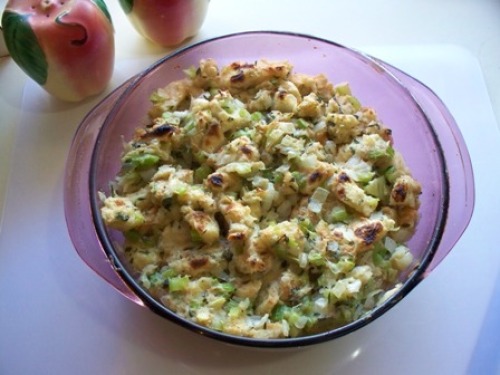
Sage Brings Back Memories
Thanksgiving has always been my favorite holiday. As a little girl, I loved watching my mom prepare the family’s holiday meal from start to finish. It was fun to watch her wrestle the turkey into the pan early Thanksgiving morning and then stuff it with her home-made sage bread stuffing.
That stuffing took several days to make because she started with a loaf of squishy-fresh bread and placed it on trays so it could dry out completely. The night before the big day, she’d saute the celery and onions, add the dried sage, mix it together and place in a bowl in the fridge. The next morning she’d stuff the turkey, skewer it closed and slide it into the oven to roast for hours.
It’s been many years since my mom made her sage stuffing, but I can still see her wearing her favorite apron and standing in the kitchen using her hands to mix the sage with the bread cubes in the big yellow bowl.
I wish I could say I follow her Thanksgiving morning ritual exactly, but I don’t. I’ve changed the routine, adapted the recipe and stopped stuffing my turkeys years ago. However, I still mix it up by hand.
Sage is Easy to Grow
Sage is so easy to grow, it’s a shame to use powdered poultry seasoning from the store for a home-made meal. Salvia officinalis is the culinary sage I grow to use in my herbed bread mixture. It can be started by transplants or cuttings and it grows equally well in the garden or in a container on the patio. I use sage fresh by plucking a few of the grey-green leaves from the plant or by drying them to add an earthy flavor to recipes. 
More info …
Dress Instead of Stuff
When the sage-bread mixture is baked in a casserole instead of stuffed into the bird, it’s called “dressing.” Even though I know the flavor is improved when used as stuffing, it’s safer to cook it outside the bird. This reduces the risk of undercooking the turkey and it allows me to control the amount of fat in the dressing.
Sage Stuffing Recipe
Whether you decide to stuff your turkey or make a side dish of dressing, a loaf of stale bread makes an excellent base and it’s frugal, too.
Ingredients
1 loaf of sliced bread (day old works fine)
4 tablespoons butter
1 large onion, chopped
4 stalks celery, chopped
1 teaspoon seasoning salt
4 tablespoons chopped fresh sage
2 tablespoons chopped fresh thyme
2 tablespoons fresh thyme leaves
2 cups chicken, turkey or vegetable broth (or water)
Salt and pepper to taste
Dry the bread by letting it sit out of its package overnight or toast in a 400 degree oven for 10 minutes. Cut each slice into cubes. Melt the butter in a large skillet and add the onion and celery. Cook over medium-high heat for about 10 minutes or until the onion and celery mixture is softened, stirring occasionally. Stir in the fresh herbs, seasoning salt, salt and pepper. Cook for 5 more minutes. Remove skillet from heat and add to the bread cubes, tossing gently to combine. Slowly add broth a cup at a time to moisten mixture to the desired consistency—the more broth added, the moister the dressing.
This recipe could be used to stuff a turkey, but I prefer to bake it separately as dressing. To bake, grease an oven-safe casserole dish and fill with dressing. Cover the casserole and bake at 350 degrees for 25 minutes. Remove cover for the last 30 minutes or until the dressing is lightly crisped on top.


















Comments
Log in or create an account to post a comment.
Sign up Log in